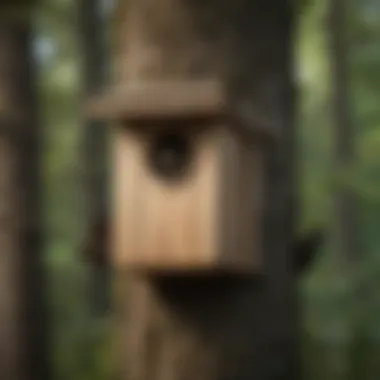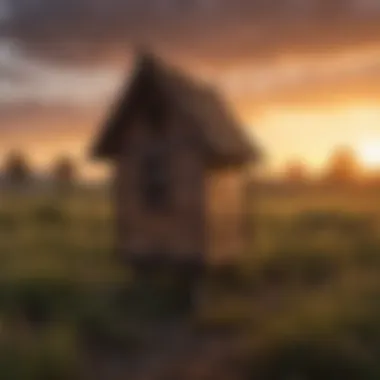Optimal Locations for Installing Bat Houses: A Guide to Effective Conservation Strategies


Overview of the Topic
Bats, being vital components of ecosystems, play a crucial role in maintaining ecological balance. The installation of bat houses in strategic locations is imperative for supporting these nocturnal creatures and ensuring their conservation. This article delves into the significance of choosing optimal sites for bat houses to attract a diverse array of bat species and aid in their population growth.
Current Status and Challenges
Currently, bats face numerous challenges ranging from habitat loss to the impact of climate change. Deforestation and urbanization have led to a decline in suitable roosting sites for bats, emphasizing the urgent need to provide alternative habitats through bat house installations. Moreover, the spread of diseases like white-nose syndrome poses a significant threat to bat populations worldwide, highlighting the importance of proactive conservation efforts.
Sustainable Solutions
To address the challenges faced by bats, sustainable solutions like installing bat houses in appropriate locations have emerged as a practical conservation strategy. By mimicking natural roosting conditions, bat houses offer bats safe shelter away from human disturbances. Successful case studies demonstrate how well-designed bat houses can attract bats and contribute to the restoration of local bat populations, showcasing the effectiveness of this conservation approach.
Impact and Importance
The conservation of bats not only benefits local ecosystems by controlling insect populations but also holds societal and economic value. Bats provide essential ecosystem services, such as pollination and pest control, contributing to agricultural productivity and biodiversity conservation. By promoting the installation of bat houses in conducive environments, communities can actively participate in bat conservation efforts, safeguarding these unique mammals for future generations.
Introduction
In the realm of bat conservation, the strategic placement of bat houses holds paramount significance. These artificial structures serve as crucial havens for bats, offering them essential roosting spaces while contributing significantly to balancing ecosystems. Understanding the importance of bat houses entails delving into their role in providing sanctuary for these nocturnal creatures and the multitude of benefits they bring to the environment. By exploring the nuances of proper placement, we can enhance conservation efforts and amplify the impact of these remarkable mammals on our surroundings.
Understanding the Importance of Bat Houses
Providing Roosting Spaces for Bats
One of the key aspects of bat houses lies in their function of providing roosting spaces for bats, mimicking their natural habitats and addressing the challenges of dwindling roosting sites in the wild. The unique design of these structures offers bats a secure shelter to raise their young and protect themselves from predators, ultimately fostering population growth and genetic diversity. Despite some limitations in accommodating certain bat species, the provision of roosting spaces remains a popular choice due to its effectiveness in attracting bats and supporting their wellbeing.
Contributing to Ecosystem Balance
The intrinsic link between bat houses and ecosystem balance stems from bats' role as natural insectivores, curbing insect populations and maintaining ecological harmony. By installing bat houses in strategic locations, we bolster bat populations, thereby intensifying their insect control abilities and reducing reliance on chemical pesticides. This virtuous cycle not only benefits local biodiversity but also safeguards agricultural yields and promotes a sustainable environment, showcasing the indispensable contribution of bat houses to ecosystem equilibrium.
Natural Pest Control Benefits
An essential attribute of bat houses lies in their provision of natural pest control benefits, leveraging bats' voracious appetite for insects to regulate pest populations in agricultural and urban settings. This biological pest management approach not only minimizes crop damage but also diminishes the spread of insect-borne diseases, underscoring the pivotal role of bats in promoting human health and food security. Despite the occasional challenges of attracting bats to populated areas, the pest control advantages of bat houses render them a valuable asset in mitigating pest-related issues and fostering ecological resilience.
Significance of Proper Placement


Impact on Bat Occupancy
The placement of bat houses significantly influences bat occupancy rates, with factors such as proximity to foraging areas, shelter from predators, and structural design playing pivotal roles. Ideal locations that facilitate bat access, provide shelter, and offer suitable microclimatic conditions enhance the likelihood of bat occupancy, ensuring the efficacy of bat houses in conserving these vital mammalian species. By strategically situating bat houses in wildlife-rich environments and considering the specific preferences of target bat species, we can optimize occupancy rates and maximize the conservation impact of these structures.
Influencing Bat Behavior
Another critical aspect of proper placement involves understanding how it influences bat behavior, from roosting patterns to foraging habits. By selecting sites that align with bats' biological needs and behavioral tendencies, we can steer their activities towards favorable outcomes, fostering successful reproduction and population growth. Factors like height, orientation, and surrounding landscape play pivotal roles in shaping bat behavior, necessitating a nuanced approach to placement that caters to the diverse requirements of different bat species.
Enhancing Conservation Efforts
Properly placing bat houses not only aids in attracting bats but also enhances broader conservation efforts by creating interconnected habitats and safeguarding biodiversity. The strategic positioning of bat houses in varied landscapes, including urban green spaces and rural habitats, amplifies the impact of conservation initiatives and fosters a more resilient ecosystem. By integrating bat houses within natural environments and mitigating external threats such as light pollution and habitat fragmentation, we fortify conservation endeavors and cultivate a conducive environment for bat populations to thrive.
[ Environmental Factors]
In the realm of bat conservation, one cannot underestimate the critical importance of environmental factors. When it comes to choosing the optimal locations for installing bat houses, understanding these factors is paramount. Environmental factors encompass a range of elements that directly influence the success of bat houses in attracting and supporting bat populations. From sunlight exposure to shelter from predators, each factor plays a crucial role in the conservation efforts for these nocturnal creatures.
[ Sunlight Exposure]
[ Ideal sun orientation]
Delving into the specifics of ideal sun orientation unveils a key element in maximizing the effectiveness of bat houses. The orientation of bat houses towards sunlight is not merely a matter of convenience but a strategic maneuver to enhance bat occupancy. The ideal sun orientation ensures that bat houses receive adequate warmth and light essential for attracting bats. This alignment is a popular choice for conservationists aiming to provide a conducive roosting environment for bats.
[ Balancing heat retention]
Maintaining a delicate balance in heat retention within bat houses is crucial for the well-being of bats. Balancing heat retention involves regulating the temperature inside the bat houses to create a comfortable space for bats to roost. This feature is favored for its ability to create a cozy environment without excessive heat buildup, contributing significantly to the success of bat conservation efforts.
[ Shelter from Predators]
[ Height considerations]
Considering the height of bat houses is more than just a physical attribute; it directly impacts the safety of bats from potential predators. The strategic placement of bat houses at ideal heights minimizes the risk of predation, providing a secure space for bats to roost. This consideration is crucial for enhancing bat occupancy and promoting a conducive environment for their conservation.
[ Distance from tree canopy]
Determining the distance between bat houses and tree canopies is a critical factor in ensuring bat safety. Placing bat houses at an optimum distance from tree canopies reduces the likelihood of predators accessing the roosting bats. This feature not only protects bats from harm but also contributes to the overall effectiveness of bat conservation efforts.


[ Accessibility for Bats]
[ Proximity to water sources]
Proximity to water sources is a vital aspect to be considered when installing bat houses. Bats require access to water for drinking and sometimes for hunting insects. Placing bat houses near water sources ensures that bats have easy access to this essential element for their survival, enhancing the attractiveness of the roosting site.
[ Avoiding light pollution]
Avoiding light pollution in the vicinity of bat houses is crucial for maintaining the nocturnal behavior of bats. Light pollution can disrupt bat activity patterns and deter them from roosting in the designated houses. By prioritizing locations away from light pollution, conservationists can create a tranquil environment ideal for supporting bat populations effectively.
Urban vs. Rural Settings
Urban vs. Rural Settings section delves into the crucial disparities between urban environments and rural landscapes in the context of bat house installations for conservation efforts. When contrasting these settings, intricate considerations arise that impact the suitability of habitat for bats. Urban areas pose challenges such as excessive artificial lighting, which deters bats from roosting in these spaces. The dense urban infrastructure, compounded by light pollution, disorients bats and disrupts their natural behaviors, affecting their occupancy in bat houses significantly. On the other hand, rural landscapes offer integration with natural habitats, providing a conducive environment for bats to thrive.
Urban Environments
Challenges of Artificial Lighting:
Artificial lighting in urban environments poses a substantial challenge to bat conservation. The excess illumination alters the nocturnal landscape, interfering with bats' foraging patterns and communication. This disturbance hampers their ability to locate suitable roosting spots, limiting their access to safe housing options. The artificial lighting also attracts insects, which, in turn, attract bats. However, this attraction to lighting sources can increase the risk of bat collisions with structures and contribute to energy depletion as bats struggle to navigate excess artificial light while hunting.
Utilizing Urban Green Spaces:
Leveraging urban green spaces for bat conservation serves as a strategic approach in mitigating the adverse effects of urbanization. Green spaces offer pockets of natural habitats within urban sprawls, providing essential foraging grounds and potential roosting sites. Incorporating bat houses within these green spaces not only enhances biodiversity but also aids in maintaining ecological balance within urban ecosystems. By utilizing urban green spaces, conservationists create vital refuges for bats, offsetting the challenges posed by urbanization and enhancing bat populations amid urban developments.
Rural Landscapes
Integration with Natural Habitats:
Integrating bat houses with natural habitats in rural landscapes fosters a harmonious environment for bat colonies to thrive. By synchronizing bat house installations with existing natural habitats, conservationists ensure that bats have access to ample food sources, shelter, and suitable roosting conditions. The seamless integration with natural environments enhances the overall biodiversity of the area, promoting a sustainable ecosystem that supports various wildlife species alongside bats.
Mitigating Agricultural Impacts:
Agricultural activities in rural landscapes can inadvertently impact bat populations, especially through habitat destruction and pesticide use. By implementing measures to mitigate these agricultural impacts, such as conserving natural vegetation, reducing pesticide use, and providing alternative roosting options, conservation efforts can effectively safeguard bats in rural settings. Additionally, promoting agro-ecological practices that prioritize biodiversity conservation can create a more bat-friendly landscape, allowing these nocturnal creatures to coexist harmoniously with agricultural activities.
Height and Orientation Considerations


eight and Orientation Considerations play a crucial role in determining the effectiveness of bat houses. The placement of these houses at optimal heights and facing the correct direction is essential for attracting bats. By considering aspects such as mounting height and facing direction, individuals can significantly impact bat occupancy and behavior. Mounting HeightMounting height refers to the specific elevation at which bat houses are installed. Ideal installation heights are typically elevated to mimic natural roosting spots for bats, such as tree cavities. This height helps in providing a suitable environment for bats to roost and rest during the day. Ideal installation heights contribute by offering bats a safe and secure space that resembles their natural habitats, increasing the likelihood of occupancy. Additionally, the higher placement helps in preventing predators from accessing the bat houses easily, ensuring the safety of the bats within.Facilitating Bat EntryFacilitating bat entry focuses on creating easy access points for bats to enter and exit the bat houses. This aspect is crucial for ensuring that bats can navigate effortlessly into the roosting space. By incorporating features such as grooved landing areas and proper venting, bat houses can facilitate entry for bats. This design facilitates smooth entry, reducing the chances of bats facing difficulties in accessing the roost. The unique feature of facilitating bat entry lies in its ability to enhance the usability of bat houses, increasing the likelihood of successful occupancy by creating a welcoming environment for bats within the house.Facing DirectionThe facing direction of bat houses plays a critical role in determining their exposure to sunlight and prevailing wind patterns. Sun and wind exposure impact the internal temperature regulation of bat houses, influencing the comfort of roosting bats. The orientation towards the sun helps in providing warmth to the bats during cooler periods, while wind exposure aids in ventilation. Optimal orientation angles ensure that bat houses receive sufficient sunlight without overheating, striking a balance that promotes bat occupancy. By aligning bat houses to face the correct direction, individuals can create a conducive environment that attracts bats while offering protection from extreme weather conditions. Optimal orientation angles guide the positioning of bat houses to maximize sunlight exposure without compromising on the comfort of bats within.
Natural Habitat Integration
Natural habitat integration is a critical aspect discussed in this article, focused on creating suitable environments for bats to thrive in. When considering natural habitat integration, several key elements come into play to ensure the effectiveness of bat conservation efforts. The benefits of integrating bat houses into wooded areas include providing suitable roosting spots within tree canopies and capitalizing on forest edge dynamics to enhance bat populations. It's essential to consider the proximity of wetlands to promote insect availability, a primary food source for bats. By strategically situating bat houses in areas with optimal natural habitat integration, individuals can significantly contribute to bat conservation efforts.
Wooded Areas
Utilizing tree canopies
Utilizing tree canopies is a crucial aspect when it comes to bat house installation, offering bats secure roosting spaces within the forest ecosystem. The key characteristic of utilizing tree canopies lies in providing bats with natural shelter and protection, mimicking their preferred roosting locations in the wild. This choice proves beneficial as it aligns with bats' natural behavior, increasing the likelihood of occupancy and long-term conservation success. While utilizing tree canopies offers a natural and familiar setting for bats, challenges may arise in maintaining and monitoring bat populations in elevated locations.
Forest edge dynamics
Forest edge dynamics play a significant role in bat habitat selection, where the edge between wooded areas and open spaces offers diverse foraging opportunities for bats. The key characteristic of forest edge dynamics is the increased insect abundance at these transitional zones, attracting bats for feeding. This aspect proves advantageous for bat conservation as it enhances food availability and biodiversity within the environment. However, potential disadvantages include susceptibility to external disturbances at the forest edge, requiring continuous assessment and management to ensure bat populations' sustainability.
Wetland Proximity
Benefits of wetland adjacency
The benefits of wetland adjacency in bat conservation primarily revolve around the abundant insect populations supported by wetland ecosystems. The key characteristic of wetland adjacency lies in the high insect biodiversity that serves as a rich food source for bats, promoting their survival and reproduction. This choice proves beneficial as it creates a favorable environment for bats in terms of food availability and ecosystem stability. Nevertheless, challenges may arise from potential flooding risks in wetland areas, necessitating careful consideration and maintenance to optimize bat habitat proximity.
Impact on insect availability
The impact of wetland proximity on insect availability is crucial for sustaining bat populations, as bats heavily rely on insects for sustenance. The key characteristic of this aspect is the direct correlation between wetland proximity and enhanced insect populations, ensuring a sufficient food supply for bats throughout the year. This choice proves advantageous for bat conservation efforts as it creates a self-sustaining ecosystem that supports both bats and insect diversity. However, the disadvantages may include seasonal variations in insect abundance, requiring adaptive strategies to mitigate potential food shortages and ensure bat population health.
Maintenance and Monitoring
Maintaining and monitoring bat houses is a crucial aspect of effective conservation efforts. By regularly checking occupancy and ensuring structural upkeep, individuals can contribute significantly to supporting bat populations. Checking occupancy involves monitoring bat populations and inspecting the frequency of bat house visits. Monitoring bat populations offers valuable insights into the health and activity levels of bats in the area. By documenting the number of bats using the houses, conservationists can track changes in population over time, aiding in conservation strategies. While frequent inspections help in assessing the usage and condition of bat houses, ensuring timely repairs and cleanings. Regular maintenance is essential for ensuring bat houses remain attractive and safe for their inhabitants. Proper structural upkeep involves repairing and cleaning bat houses when needed, which contributes to the longevity and functionality of the installation. Preventive maintenance tips also play a vital role in proactive care, preventing potential damage and addressing issues before they escalate. By following these guidelines, individuals can maximize the effectiveness of bat houses in promoting conservation efforts.
Conclusion
In the realm of bat conservation efforts, the art of selecting the perfect location for installing bat houses emerges as a pivotal aspect. The conclusion drawn from our exploration into optimal locations for installing bat houses carries immense significance, as it encapsulates the essence of contributing to the well-being of bat populations. By strategically situating bat houses in suitable habitats, individuals effectively extend a welcoming haven to these nocturnal creatures, fostering their presence and aiding in their conservation. The holistic approach of this article illuminates how each decision regarding bat house placement can impact the intricate ecosystem dynamics, emphasizing the interconnectedness of species and habitats in the broader conservation narrative.
Enhancing Bat Conservation Efforts
Impact of Individual Contributions
Delving into the intricate realm of individual contributions to bat conservation, a nuanced understanding emerges that underscores the essence of collective action. The impact of individual contributions transcends mere numbers; it symbolizes a collective commitment to safeguarding biodiversity by providing essential roosting spaces for bats. This act not only aids in preserving bat populations but also creates a ripple effect that reverberates through the ecosystem, contributing to the overall balance of nature. The key characteristic of individual contributions lies in its ability to serve as a tangible manifestation of environmental stewardship, where each small effort accumulates into a substantial force for positive change. In the context of this article, the emphasis on individual contributions accentuates the agency of each person in making a tangible difference, highlighting the power of collective action in conservation endeavors.
Promoting Biodiversity
Within the tapestry of promoting biodiversity, a compelling narrative unfolds, emphasizing the intrinsic value of fostering a rich tapestry of life forms. Promoting biodiversity through the installation of strategically placed bat houses signifies a conscious effort towards nurturing environmental resilience and sustainability. The key characteristic of promoting biodiversity lies in its ability to enhance ecosystem resilience by providing habitats for a diverse array of species, including bats crucial for maintaining ecological balance. This deliberate action not only enriches local biodiversity but also cultivates a harmonious coexistence between different organisms within their shared habitats. In the context of this article, promoting biodiversity emerges as a cornerstone of effective conservation practices, showcasing how each deliberate step towards enhancing species diversity contributes to the overall health of the environment.



